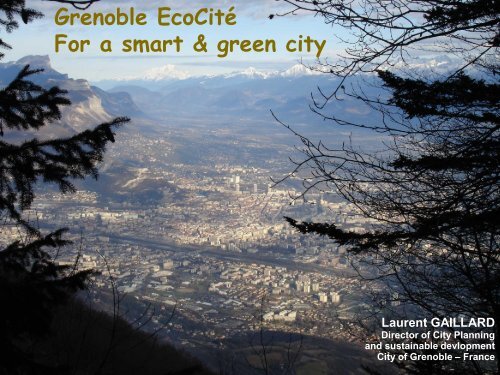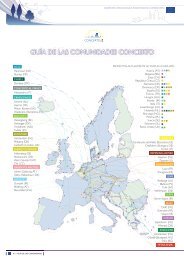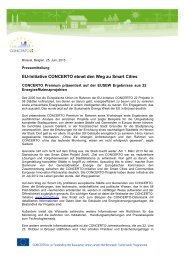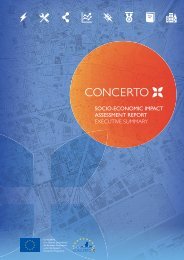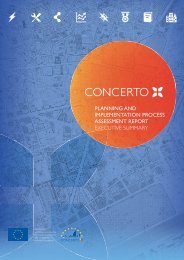Showcasing the Transition from a City to a Smart City
Showcasing the Transition from a City to a Smart City
Showcasing the Transition from a City to a Smart City
You also want an ePaper? Increase the reach of your titles
YUMPU automatically turns print PDFs into web optimized ePapers that Google loves.
Grenoble EcoCitéFor a smart & green cityLaurent GAILLARDDirec<strong>to</strong>r of <strong>City</strong> Planningand sustainable devlopment<strong>City</strong> of Grenoble – France
Grenoble in <strong>the</strong> Rhône-Alpes Region, in FranceRhône-alpes : 6 million people6th most populated region inEurope (demographic growth)A dynamic region (GDP 100-125)Member of EuroRegion Alpes-Mediterrannée
At <strong>the</strong> foot of 3 ranges of Alpin mountainsAnd <strong>the</strong> jonction of 2 rivers Drac and IsèreGrenoble :Urban area : 700 000 inhabitants150 communitiesMetropolitan area : 450 000 inhabitants27 communities,Central <strong>City</strong> area : 160 000 inhabitants
An outstandingquality of life
A nice place <strong>to</strong> live !
Grenoble :An enormousurban growthduring 20thGrenoble, 19th centuryCenturyA huge urban extension in <strong>the</strong> 50ies, 60ies and 70ies
Inventing new sustainable developmenturban models◦ In 2050, 70% of<strong>the</strong> world’spopulation will livein <strong>to</strong>wns◦ The challenge is <strong>to</strong>find <strong>the</strong> way <strong>to</strong> live<strong>to</strong>ge<strong>the</strong>r in <strong>the</strong>heart of our cities◦ Grenoble mustimagine <strong>the</strong> <strong>to</strong>wnof <strong>to</strong>morrow : anintegrativeapproach of <strong>the</strong>urban environment
TRANSPORTThe tram picks up speed+ + + Grenoble, <strong>the</strong> posi+ive energiesInventing <strong>the</strong> compact<strong>to</strong>wn of <strong>to</strong>morrow• 33 km of tram tracks in<strong>the</strong> Grenoble built-upurban area• 2 new lines in creation• Mobility mode share• Electric mobility schemeon reflexion• The Grenoble “bicyclereflex”
ENERGIES AND PROTECTION OF RESOURCES+ + + Grenoble, <strong>the</strong> posi+ive energiesWood, sun and water in <strong>the</strong> vicinity of sensorsFocusing onrenewable energiesand <strong>the</strong> reduction ofCO2 emissions• The most powerfulbiomass heat plant inFrance• The Town supports <strong>the</strong>competitiveness centres• A new natural regionalreserve on its drinkingwater catchment
ECO DISTRICTS+ + + Grenoble, <strong>the</strong> posi+ive energiesImagining <strong>the</strong> <strong>to</strong>wn of <strong>to</strong>morrowGrenoble hasexperimented afunctional and socialmix : <strong>the</strong> De Bonne Eco-District• Experimentation withConcer<strong>to</strong> of a districtwith high energyefficiency• Transport• Social mix• Functional mix
De Bonne Eco-District :A sustainable districtin <strong>the</strong> centre of <strong>the</strong> city2003-2009Early Concer<strong>to</strong> program
De Bonne Eco-District : in <strong>the</strong> heart of cityReconversion of ancien military barracks on 8,5 hectaresEuropean program Concer<strong>to</strong> on energy efficency and renewable energy
De Bonne Eco-District : in <strong>the</strong> heart of city• inlarge <strong>the</strong> centre and connect <strong>to</strong> <strong>the</strong> new tramway line, 900 dwellings within 40%social housing appartement.• a new wood structure shopping center : 20 000 m² of shops cooling by water tablesystem and equiped with 1000m² solar PV panels.• A new urban parc of 5 hectares,Urbaniste : Christian Devillers,Architecte en Chef : Loïzos Savva, Aktis
First National Award for Sustainable Eco-District in 2009
De Bonne Eco-District : in <strong>the</strong> heart of cityA shopping center : 20 000m² Wood frame,1000 m² PV panel, cooling with water table
De Bonne Eco-District : in <strong>the</strong> heart of cityThe first positiv energy office building in France
De Bonne Eco-District : in <strong>the</strong> heart of cityNew and renovatedhigh energy efficency dwellings
De Bonne Eco-District :in <strong>the</strong> heart of citySustainable construction- 79KwEP/m²/yr (heating and hot water)- External insulation- Wood frame windows- Double flux ventilation- Solar panel for water heating- 8 CHP gaz power for heatand electricity- Green roofs and realgardens in each block
Moni<strong>to</strong>ring results : Heating and hot water consomption over 2011Consomption Concer<strong>to</strong> objectivs for heating and hot water = 70 kWh ep /m² /year (Primary Energy)(Primary Energy)Hot waterHeatingDwellings Consomption Average :Heating+ hot water Concer<strong>to</strong>: 7038• Compare <strong>to</strong> <strong>the</strong> average over 18 classic buildings in 2011 : 126 kWhep/m²/year• de Bonne dwellings consomption is 40 % lower
kWh ep/m²shab.an70Moni<strong>to</strong>ring Compare 2010/2011:Electricity consomption for common functionsMoyennes sur 9 bâtiments (sans H1,H2): 2010: 40 kWhep/ m²Shab2011: 37 kWhep/ m²Shab6012%2010 201150402020%Objectif 30 Concer<strong>to</strong>:25,88%5%-1%-6%-13% -19%-100-10• Electricity french ratio <strong>from</strong> primary energy <strong>to</strong> final energy : x 2,58* Estimation 2011 à partir des donnéessur Ventilation 6 mois simple flux
First Priority : Retrofitting of existing buildingsOne exemple : Main Boulevard Project (before <strong>the</strong> work)Also included in Concer<strong>to</strong> Sesac project bu<strong>to</strong>nly for <strong>the</strong> studies
Main Boulevard after <strong>the</strong> workA new lease of life for <strong>the</strong> Main Boulevard!
Main Boulevard after <strong>the</strong> workAn integrated approach renovation :- Appartments energy and facade renovation- Shops and small businesses renovation- New public space for pedestrians and bicycles- A new Tramway line divided by 2 cars space
Area covered
Main Boulevard results2005-2009- All facades renovated- 637 appartements concerned byenergy efficiency renovation.- 13 small businesses renovated- 9 offices building involved in savingenergy- Energy saving : 370 <strong>to</strong>e / year.- CO2 emission reduction : 700 t / year- Cost of work : 7 millions €- Public Grants : 1.6 million €- Effects :- Large owners incentive- lot of o<strong>the</strong>rs multi-ownership ready<strong>to</strong> make <strong>the</strong> same work- A new project at <strong>the</strong> agglomerationscale has started already <strong>to</strong>wardsbuilding built between 1945 and 1975
La Villeneuve Arlequin : <strong>Smart</strong>cities Project ZenN
European program <strong>Smart</strong>Cities 2012.8.8.3Project ARLEQUIN ZenNRetrofitting of 433 dwellings (32 475 m²)SDH / 40 Arlequin :Réhabilitation de154 logementsCopropriété 80 Arlequin:Réhabilitation de 37logementsCopropriété 100Arlequin :Réhabilitation de 153logementsACTIS / 50 Arlequin :Réhabilitation de 89logements
Aujourd’hui l’avenue Alfred de Musset
L’avenue du Parc au croisement avec la rue de l’Arlequin
Developing a positiv energy strategy in <strong>the</strong> urban projectsA Shared Responsibility of Public and Private Shareholders
Fac<strong>to</strong>r 4Grenobleengagement :Divide by 4energyconsumptionandemissions ofgreenhousegases with allpartners for2050compare <strong>to</strong>2005
Evolution des différents critères de qualité environnementale depuis 200510080604020isolation %solaire %terrasses végétalisées %02004 2005 2006 2007 2008En 2008, 90 % des PC avec isolation par l’extérieur80 % avec terrasses végétalisées60 % avec panneaux Solaires
Grenoble Ecocité is supportedby national investment foundsAnd under negociation phasewith <strong>Smart</strong>Cities 2Project name : <strong>City</strong>ZenLeader : Amsterdam
A local energy strategyGrenoble EcoCité+ Learns <strong>from</strong>Concer<strong>to</strong> project
The 2 e heating district of France, with 55 % renewable energy,91 000 points provide, 136 km of network, 3 CHP137 g of CO2 per KWh sold
Grenoble Presqu’ile scientific quarterDemonstration site of <strong>the</strong> EcoCité project250 ha for a carbon free and fossil energy free way of life
Grenoble Presqu’ile scientific quarterDemonstration site of <strong>the</strong> EcoCité project250 ha for a carbon free and fossil energy free way of lifeAtelier de Portzamparc Architecte Urbaniste
Au<strong>to</strong>partageCar sharingPublic TransportsPavillon of <strong>the</strong> Mobilitieselectric vehiclesservicesMobility Passon your smart phonenew job : Mobilities Opera<strong>to</strong>rdynamicCovoiturageSelf-service smallurban electric carSelf-service bicycles
Step 1Step 2Mobility strategyMastering <strong>the</strong> parkingOffer convenient, moderate-cost,easy <strong>to</strong> use mobility solutionsAll parking places under publiccontrol : « Pavillons des mobilités »Mobility PassStep 3Substitute individual vehicle byshared vehiclesComplete public transport withcar-sharing & last-mile solutionsStep 4Switch <strong>to</strong> hybrid/electrical cars andsolar power supplyOffer easy charging facilities(at home/at work)Step 5<strong>Smart</strong> management of ElectricVehicule batteriesPavillons des mobilité and Solarparkings
SmallHydro-electricityproductionConsomptions display& <strong>Smart</strong>GridGeo<strong>the</strong>rmal forinter season s<strong>to</strong>rageHeating and coolinggrid + electric<strong>Smart</strong>grid integratedNew job : Energies Opera<strong>to</strong>rPho<strong>to</strong>-voltaïcmassiv productionPolygenerationBiomass plan<strong>to</strong>n <strong>the</strong> existingdistrictHeating &cooling gridlowtemperaturewith wasteenergyusesCENTRALEPRODUCTION DECHALEURINDUSTRIES /RECHERCHESLOGEMENTSCOLLECTIFSPARC DE SONDESGEOTHERMALESPROCESSBUREAUX
General ContextWorld Population Growth (70% in cities by 2050)Natural ressources <strong>to</strong> be savedSpace Raw Materials EnergyVertical HousingSort, re-use, repairRenewable EnergySources replace fossilUrban density <strong>to</strong> be softenedby nature and humanrelationshipsAdapted buildingdesign andbehavioursSave energy, produce locallyA urban system <strong>to</strong> master energy(≠ massive energy for ever-growingneeds)Integrated <strong>to</strong>wn design associated with cooperation, ressources-care & way of life= EcoCité
EcoCité specifics challenges‣ Replace fossilenergyElectricity 20.4 GWh/yMobility24.0 GWh/yRenewable productionElectrical MobilityHeating 27.2 GWh/y Fatal & recovery fuels‣ Reduceconsumption‣ Introducenature in cityblocks‣ Help people<strong>to</strong> sort anreduce wasteLow energy buildingsPeak management &s<strong>to</strong>ragePreserve mountainviewsProvide public & private«nature islands »Adapt housingProvide built-in wastemanagt & repair facilities30 kWh/m².y target<strong>Smart</strong> grid etcooperative buildingsHigh housing buildingsVertical gardenWaste ressources
Au<strong>to</strong>partageRecreative shared spacesShared gardensKeeping olds peopleWaste managementIntegratedurban blocksA new job : Block ManagerMutualised appartementBioclimatic greenhouseEasy park bicycles spaces
Impact of Ecocité principleson city blocks designLow temp. heating Loop :- Reversible heat/coldACSMobility system :- No private parking- Real time information- Easy deliveryVertical gardens◦ 30 kWh/m²/yr <strong>to</strong>talenergy consumptionfor new buildings atstandard costs◦ Consumption becomeslargely electrical(electricity represents50 % and heat /cold50 % of energy needs)◦ Investment cost >>operation cost<strong>Smart</strong> grids :- Remote controlelectrical equipement<strong>City</strong> blocks, energy and mobility systems are designedas integrated, cooperative, industrial systems
Vertical gardensEIFFAGE – Philippe Bar<strong>the</strong>lemyCOGEDIM - Edouard François
EsplanadeAtelier Christian de Portzamparc
Grenoble EcoCité stakeholders
Avec mention de crédit pho<strong>to</strong> CEAplateforme Moni<strong>to</strong>ring Véhicules Electriques du CEA-LITEN.Economic sec<strong>to</strong>rsAu<strong>to</strong>motivesec<strong>to</strong>r<strong>Smart</strong> gridBuildingWood / Timber
Cities = where public and private partnership are possibleEcocity project propose an integrated <strong>to</strong>wn design for a carbon free districtProjects are concerning various fields in an integrated approach:- Mobility (electric vehicles, new services of mobility, cycles and tramway)- New energy efficient buildings- RES : hydropower plant, PV plant, Biomass cogeneration plant..- <strong>Smart</strong> gridPublic and private partnership around innovativeproject on Presqu’île district
Cities = where 70% of <strong>the</strong> european population are livingCities policy and targets are close <strong>to</strong> europeanpolicyUrban policy :• Compact city,• Retroffiting of housing, new districts• New MobilityEnvironmental policy :• CO2 emission reduction targets• Nature, green spaces and biodiversity• Renewable energy,Social cohesionAttractivity : create jobs
Cities = where public and private partnership are possiblePositive aspects :• University / Research / Industry good cooperation• Close cooperation between various stakeholders around sameobjectivesDifficulties :• Public authorities must follow tender rules of « marchés publics »• Who hold <strong>the</strong> innovative risk when private have return on investmentin mind ?PPP are good development <strong>to</strong>ols only if :• Public authorities have a leadership role• Public authorities are warrant of public interest• Public authorities are close <strong>to</strong> citizen participation


